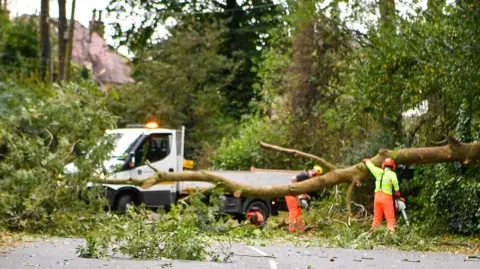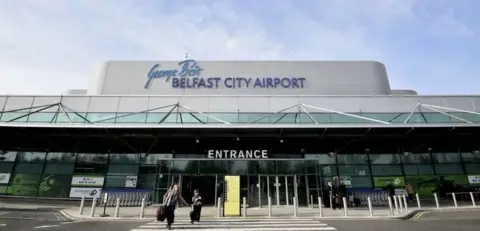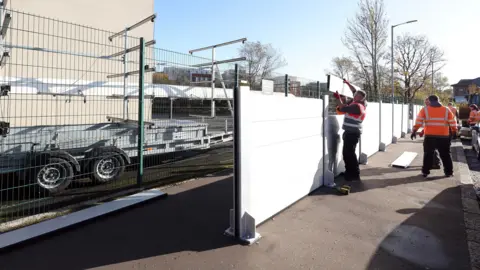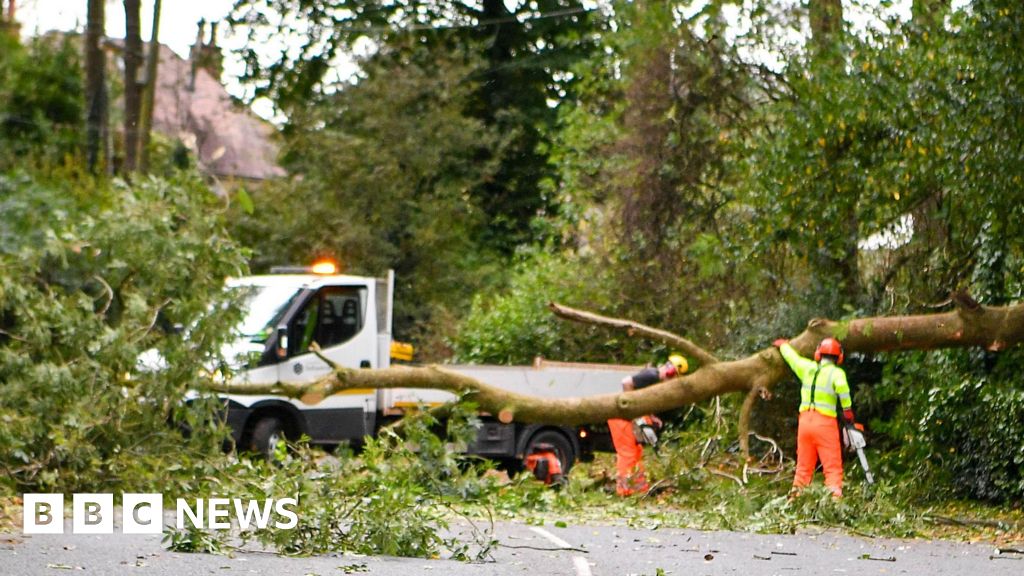 Pacemaker
PacemakerMore than 2,000 homes are currently without power across Northern Ireland due to high winds.
Dozens of flights have been cancelled at Belfast City Airport and Dublin Airport as Storm Ashley continues to cause disruption.
The Met Office has issued an amber warning for western counties from 13:00 BST to 20:00. However, a yellow warning for wind remains in place for all of Northern Ireland until midnight.
Gusts of up to 115km/h (70mph) have been predicted.
 bbc
bbcIn a passenger update posted on X, Dublin Airport said weather conditions had led to some airlines cancelling flights.
The cancellations mainly affect Aer Lingus flights.
Allow Twitter content?
Meanwhile Stenaline and P&O sailngs between Northern Ireland and Scotland are heavily affected, with most sailings on Sunday cancelled.
Translink is also warning of possible disruption to the rail network on Sunday, due to the weather conditions.
Northern Ireland’s Department for Infrastructure said temporary tidal flood defences were being deployed along the River Lagan at high-risk areas such as Lockview Road and Cutters Warf in south Belfast.
 pacemaker
pacemakerNewry, Mourne and Down District Council said the district’s four forest parks (Castlewellan, Delamont, Kilbroney and Slieve Gullion) are closed to the public on Sunday due to the increased likelihood and risks associated with falling branches and debris.
Fermanagh and Omagh District Council have also announced closures of some outdoor council facilities, including Gortin Glens Forest Park.
And in the Derry City and Strabane District Council area, all public parks and grass pitches are closed as are recycling centres at Pennyburn, Strathfoyle, and Strahan’s Road.
Armagh City, Banbridge and Craigavon council announced that there may be a delay in opening household recycling centres on Monday.
Allow Twitter content?
Met Éireann, who issue warnings across the Republic of Ireland, named the storm and issued its second-highest level of warning – Status Orange – for counties including Galway and Mayo, from 10:00 local time on Sunday until 20:00.Very strong winds are forecast across the whole of Ireland and parts of Great Britain, especially Scotland.
Along exposed coasts and high ground, gusts may reach up to 70-80 mph (113-129km/h).
The Met Office have issued an amber warning for wind for counties Fermanagh, Tyrone, Londonderry and parts of Antrim from 13:00 until 20:00. It’s the second highest level of alert and the meteorological service says “some disruption to transport and power supplies is likely”.
The entire west coast of the Republic of Ireland is under an orange warning.
That’s the second highest level of warning and indicates an increased risk of damage and disruption.
Met Éireann is forecasting coastal flooding, difficult travel conditions, and dangerous seas along counties Clare, Kerry, Donegal, Galway, Leitrim, Mayo, and Sligo.
A yellow warning was issued across the rest of the country from midnight on Saturday until 03:00 BST on Monday.
‘Do not place yourself or others in unnecessary danger’
The Police Service of Northern Ireland (PSNI) are advising road users to consider if their journey is necessary and to take extra care if travelling.
In a statement they said: “If you must travel, please bear the prevailing conditions in mind. Your journey may take longer than normal, please drive slowly to minimise the impact of wind gusts, and be aware of high-sided vehicles on more exposed roads. Fallen trees or flying debris are possible in the gale force winds.”
Assistant Chief Constable Davy Beck added: “Consider the potential risks before you leave. Do not place yourself or others in unnecessary danger.”
Why are storms named?
The latest storm name season started on 1 September and will be used until 31 August 2025.
Ashley is the first name on the alphabetical list so the next storm would be named Bert, followed by Conall.
Storms can be named by the Met Office, Met Éireann or the Netherlands meteorological service (KNMI) if any believe impacts from severe weather are “medium” or “high”.
It is thought that by naming storms, it gives the public a greater awareness of the potential impacts of severe weather.
Note:- (Not all news on the site expresses the point of view of the site, but we transmit this news automatically and translate it through programmatic technology on the site and not from a human editor. The content is auto-generated from a syndicated feed.))




